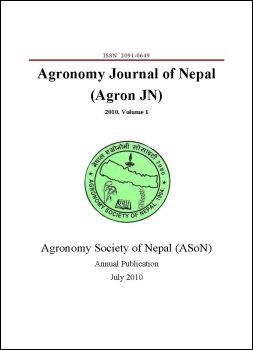On-farm comparison of improved maize variety Manakamana-3 with Local Thulo Seto for grain yield and agronomic attributes at Dukuchhap, Lalitpur, Nepal
DOI:
https://doi.org/10.3126/ajn.v1i0.7537Keywords:
Yield and agronomic attributes, bivariate relationship, interaction effectAbstract
On-farm studies were carried out at Dukuchhap, (1100-1500 m), Lalitpur, an Outreach Research Site of Khumaltar complex during 2006-2007 full season maize growing (May-Sep). The study consisted of comparison among grain yield, and agronomic attributes between Manakamana-3, an improved OPV and Local Thulo Seto maize varieties. Field surveys were conducted to gather information on aforesaid attributes of these maize varieties. In 2006, data were recorded from 265 plants for Local Thulo Seto and 131 plants from different fields for Manakamana-3 while in 2007 they were recorded from 180 plants for both varieties. The result of the study revealed that both of these varieties were comparable for grain yield and ear length. However, combined analysis over years for plant and ear height, ear fill, and ear circumference showed a highly significant result. It was also recorded that plant height, ear height and ear filled remained dynamic between these varieties over years. Plant height of Local Thulo Seto was exceptionally tall up to 364 cm compared to Manakamana-3 which attained a plant height up to 241 cm. The most important yield parameter of grain weight/ear was not affected due to years and varieties. Bivariate relationship among grain yield and agronomic attributes showed that grain weight/ear was highly correlated with ear length (r=0.73**), ear fill (r=0.75**), and ear circumference (r=0.63**). Ear height was not correlated with grain yield. It was also observed that plant height has a negative relationship with grain yield and ear attributes except for ear height which was positively correlated with plant height. Maize variety Thulo Seto is popular in Dukuchhap where area coverage of this variety is more than 80% in the locality. There is a serious limitation of this variety at Dukuchhap because of stalk lodging which was severe in 2006 as a result around 80% plants have the problem of stalk lodging. Farmers preferred this variety because it is resistant to early drought which is another problem for maize growing at Dukuchhap. Therefore, if we improve population of Thulo Seto in farmers’ field and reduce plant height of this variety by way of population improvement there is no need of introducing new varieties of maize in immediate future at Dukuchhap and similar domain in Lalitpur.
DOI: http://dx.doi.org/10.3126/ajn.v1i0.7537
Agronomy Journal of Nepal (Agron JN) Vol. 1: 2010 pp.10-15
Downloads
Downloads
Published
How to Cite
Issue
Section
License
ASON permits for free use, distribution and reproduction in any medium if the original work is properly cited and not used for commercial purposes.




